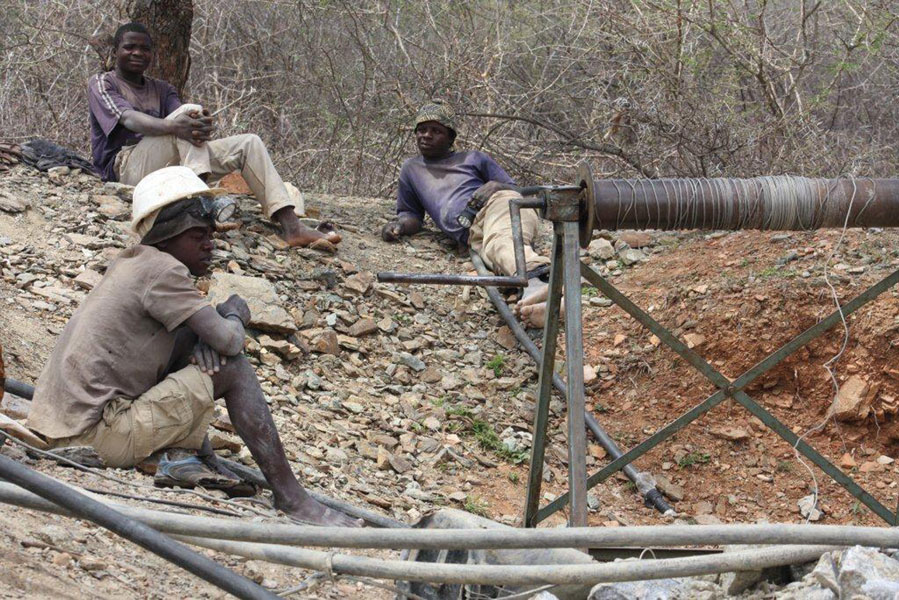
BY CHANTELLE KOTZE
Gold producer Caledonia Mining Corporation has successfully completed the shaft sinking phase of its Central Shaft project at its 49%-owned Blanket mine in Zimbabwe.
It is well on track to increase gold production to 80 000 ounces per annum from 2022 and onwards following completion of the project in 2020.
The central shaft, at a depth of 1 208 m at shaft bottom, will now be equipped and commissioned over the next 12 months, Caledonia CEO Steve Curtis said.
The central shaft project is the largest investment in a series of investments at the Matabeleland South-based mine in a bid to increase production, improve operating efficiency and extend the life of the 113-year old mine even further.
It will also deliver significant increases in the company’s profit and distributable cash, the company believes.
The Central Shaft project, as part of the company’s life of mine extension plan at Blanket, has been in progress since early 2015 and the company has spent approximately US$44 million sinking the new shaft to unlock additional resources from deep underground.
Currently in the equipping phase, prior to commissioning (expected during the second quarter of 2020), gold production from Blanket mine is expected to progressively increase to the 80 000 ozpa of gold by increasing its production from the 50 000 oz to 53 000 oz of gold as per its 2019 production guidance.
- Chamisa under fire over US$120K donation
- Mavhunga puts DeMbare into Chibuku quarterfinals
- Pension funds bet on Cabora Bassa oilfields
- Councils defy govt fire tender directive
Keep Reading
Prior to the execution of the Central Shaft project, Blanket mine operated to a depth of 750 m, accessed via No.4 Shaft (the only operational shaft).
The Central Shaft project will extend this depth to just over 1 200 m, allowing the addition of three new production levels to the mine below the current 750 m level – on 26 (870 m), 30 (990 m) and 34 (1 110 m) levels.
The latest mine plan also allows for the development of a fourth production level on 38 level (1 230 m below surface) which will be accessed via a decline shaft.
The mine, although operated from the single No.4 shaft, comprises five significantly independent near vertical ore bodies.
The brainchild of COO Dana Roets, the Central Shaft – aptly named so because of its central location in relation to the five ore bodies – will enable the access of deeper ore bodies more efficiently.
“Because the current shaft is located on the extremity of the ore bodies, we only mine in one direction, but the centrality of the Central Shaft will allow us to mine more efficiently in both directions along the 3 km strike on all three levels.
“This will allow us to access the mining areas in approximately half the time and also reducing worker’s traveling time significantly,” Curtis explained.
Having reached shaft bottom at 1 208 m in July, the bottom and mid shaft loading stations have already been established and development work from the Central Shaft to the ore bodies is advancing well – with one of the production levels having already reached the ore body.
This development work has allowed for the simultaneous establishment of the ventilation shaft and ore raises via raisebore drilling.
“With 12 months to go from an equipping perspective, we are in a very good space to ramp up production to approximately 75 000 oz in 2021 until Blanket reaches the 80 000 ozpa target in 2022 and onwards,” said Curtis.
The company has lost some momentum at Blanket as a result of electricity supply interruptions experienced at the mine resulting from the broader unstable electricity supply challenges in Zimbabwe.
Caledoni has resultantly had to revise its production guidance downward from between 53 000 and 56 000 oz to between 50 000 oz and 53 000 oz of gold for 2019.
Curtis admitted that the electricity supply challenges in past 12 months have been particularly disruptive to the project, particularly during the month of July and in early August.
“This resulted in the heavy reliance on the 12 MW installed diesel generator back-up capacity at the mine – sufficient to run the entire mine at full capacity but insufficient to sustain both the mine and the Central Shaft project,” he explained.
The power situation has, however, improved substantially in late August and September thanks largely to a timely and coordinated response from the Chamber of Mines, the Ministry of Mines, the Ministry of Energy and Power Development and the Zimbabwean Energy Regulatory Authority, which introduced a new United States dollar-based electricity pricing structure for the mining industry to support the funding of imported electricity which is used exclusively to supply participating mining companies.
The electricity supply authorities have also implemented an uninterrupted power supply agreement for the mining industry in an effort to support the sector and electricity supply has stabilised following these changes.
Despite the improved electricity situation in Zimbabwe’s mining industry, Blanket has purchased an additional 6 MW of diesel generator capacity, taking its diesel generation capacity up to approximately 18 MW of total installed capacity.
While cognisant of the cost and availability of diesel in Zimbabwe, Curtis saied Blanket will be cautious in the way it uses this generation capacity.
With generators ranging in size from 1 MW to 2.5 MW, all of which have been synchronised into the mine’s electricity usage grid, Blanket has a significant amount of flexibility in that it will be able to switch on only what is needed when it is needed.
“The additional generators are on site and are currently being installed after which Blanket’s operations will be fully protected from the risk of unstable electricity supply and will ensure future reliability in the face of a potentially difficult electricity supply situation in the southern African region in the medium to long-term,” Curtis noted — Mining Review Africa











